Thessaloniki’s Long-Awaited Transformation Takes Shape
From major infrastructure projects to a...
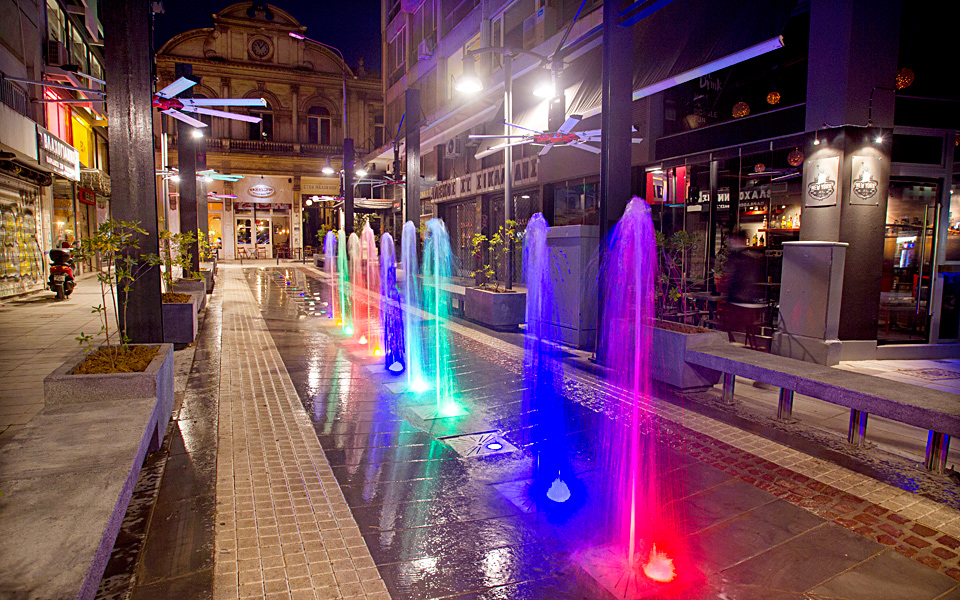
Fountains in front of the historical building which housed the former Bank of Thessaloniki
© Alexandros Avramidis
It’s a sweet spring afternoon on Chrimatistiriou Square, in the heart of what is known as “Frangomahala” – an area in Thessaloniki that was once bustling with commercial activity. Small municipal sweepers come out, a little too early, to clean the freshly-paved stone paths. Other workers meticulously clean the fountains and turn on the huge fans that hang overhead – an image that at first seems to mismatch the surrounding urban landscape. Soon, the wider – and now remodeled – area of Chrimatistiriou Square will come alive, like it does each morning.
The square was redesigned recently, acquiring a radical bioclimatic character. The scientific team behind the project hopes that, thanks to its interventions, temperatures during the summer months will be lower by five degrees centigrade on average.
Over the last two years, the area – bordered by Egnatia, Ionos Dragoumi, Tsimiski and Dodekanisou streets – became second home to scientist Spyros Kanouras and architect/engineer Angeliki Hatzidimitriou, two freelancers working for the Technical Service of the Municipality of Thessaloniki. They were advisers on matters of bioclimatic redevelopment in the area.
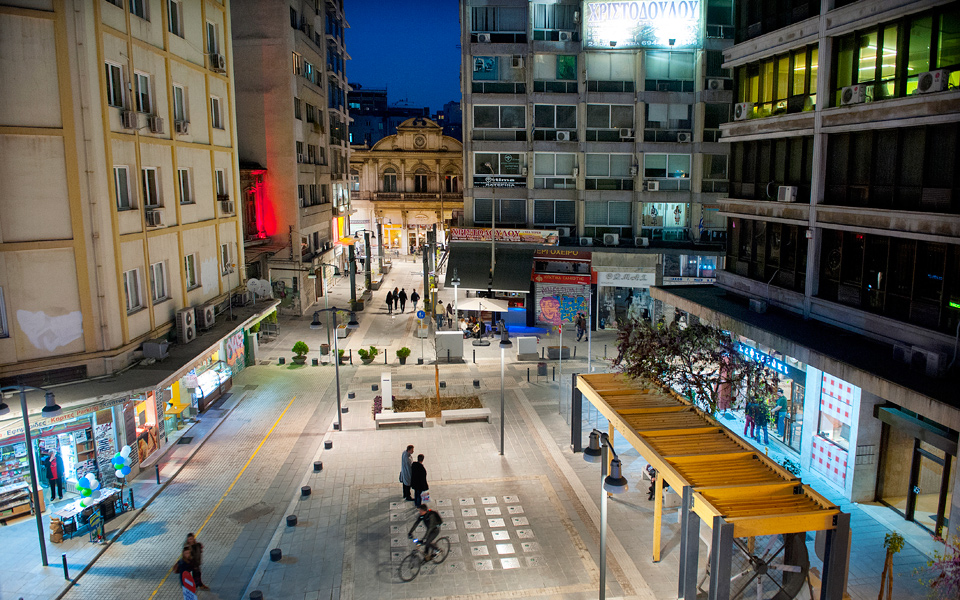
Chrimatistiriou square
© Alexandros Avramidis
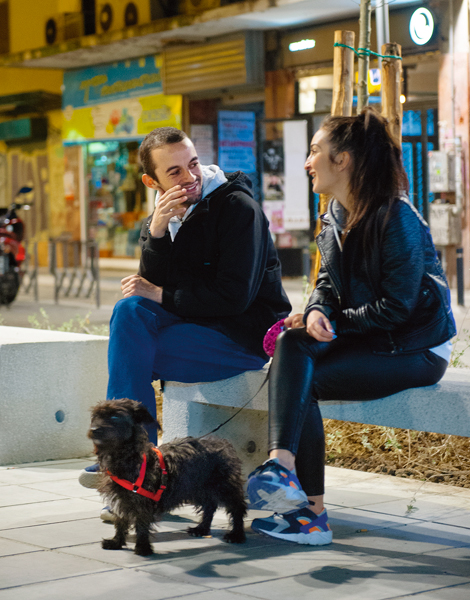
More and more people are discovering the area, which before was a badly lit space used for parking
© Alexandros Avramidis
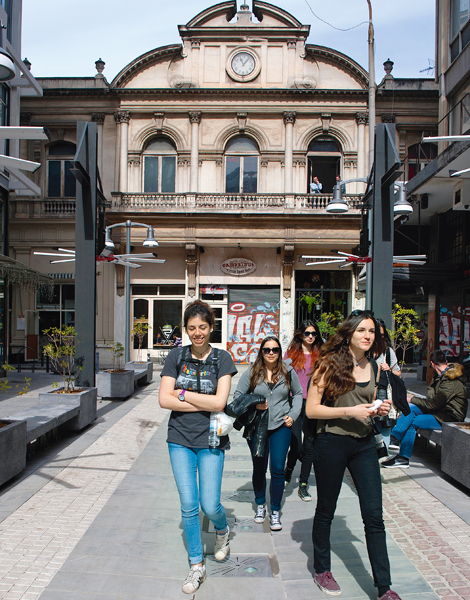
Young people walk in the square
© Alexandros Avramidis
“The goal of the bioclimatic redevelopment was to reduce the air temperature during the hotter months and the temperatures emitted from surfaces like the pavement, or the street”
“The goal of the bioclimatic redevelopment was to reduce the air temperature during the hotter months and the temperatures emitted from surfaces like the pavement, or the street,” explains Hatzidimitriou, adding that the main hope was to also improve the sensation for pedestrians. To get the desired temperature results, solutions included planting trees, paving new walkways and streets (made with ‘cooling’ materials, with cement as their foundation), and adding water: fountains, water-curtains, and sprinklers.
For many years, this specific area was dark and neglected, serving as a vast and chaotic parking lot and a rundown nightlife hub. Today, it is well-lit, clean and more orderly.
Families with strollers and groups of young friends stop to photograph the six large fans placed on metal foundations on the upper part of Chrimatistiriou Square – what seems to be a new trend in Thessaloniki. A few blocks away, at Plateia Emporiou a large wooden arch is also home to a big fan. Fan propellers are powered by electricity. They don’t make any noise, and stop working at night to conserve energy.
The redevelopment covers an area of 110,000 square meters. The total budget for this project amounted to €5.5 million, and was covered by the National Strategic Reference Framework (NSRF), following a few hitches regarding the disbursement of finances. The result, however, goes way beyond initial expectations. Kanouras and Hatzidimitriou estimate that the bioclimatic interventions can lower temperatures by 9°C on surfaces, and as much as 2°C in air temperature.
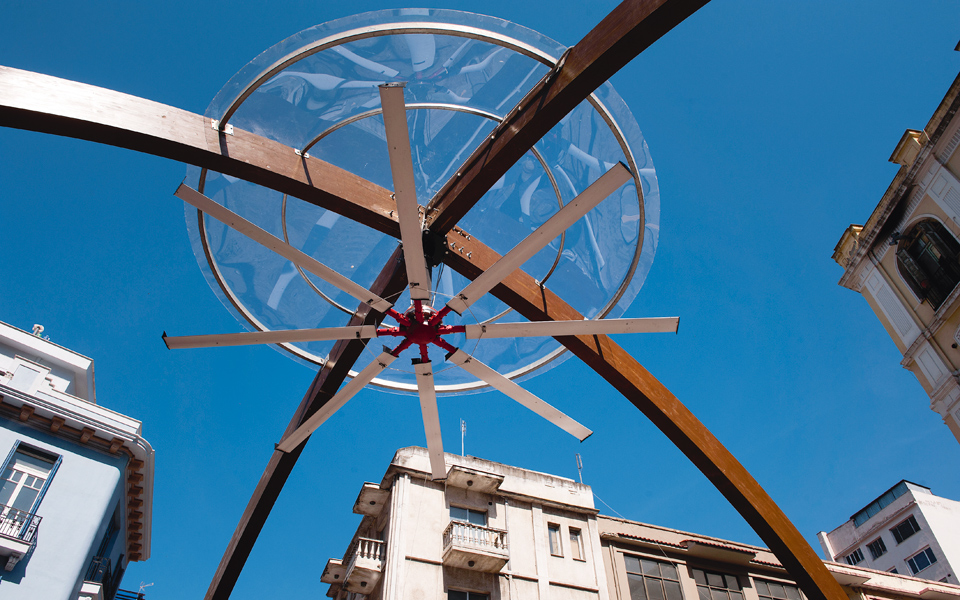
At Plateia Emporiou a large wooden arch is also home to a big fan
© Alexandros Avramidis
The neighborhood’s makeover has been met with varying responses. Shop-owners discussed the work done a little beyond their storefronts, feeling proud for the transformation which, they feel, is a sign of a newfound respect for public space. While perusing the new construction, they promise to guard the area from “vandals”.
The project, however has also been met with criticism. Some complain about the fact that the new trees, until now, sit in pots (and are not being planted in the soil). Also negatively discussed are the large electric power boards placed at the center of the square.
George Koukouvitis is the owner of a local food store, one of the oldest stores in the area. There is no foodie or chef who has not passed through here. He believes “remodeling is definitely a positive step”. “We won’t become like Dubai (a symbol of ultra-modern structures) of course,” but he is confident positive change is ahead.
Today, the area is a different world during the day and another one at night. In the mornings, it is a land of office workers and young entrepreneurs, and of stores selling household and DIY items – from bedding to ironware. At night, it is transformed into the nightlife spot that it is. “We’re hoping to make these two worlds meet after the redevelopment”, had said the President of Thessaloniki’s Trade Association, Pantelis Filippidis, at the ceremony after the works were complete.
“The bioclimatic interventions can lower temperatures by 9°C on surfaces, and as much as 2°C in air temperature”
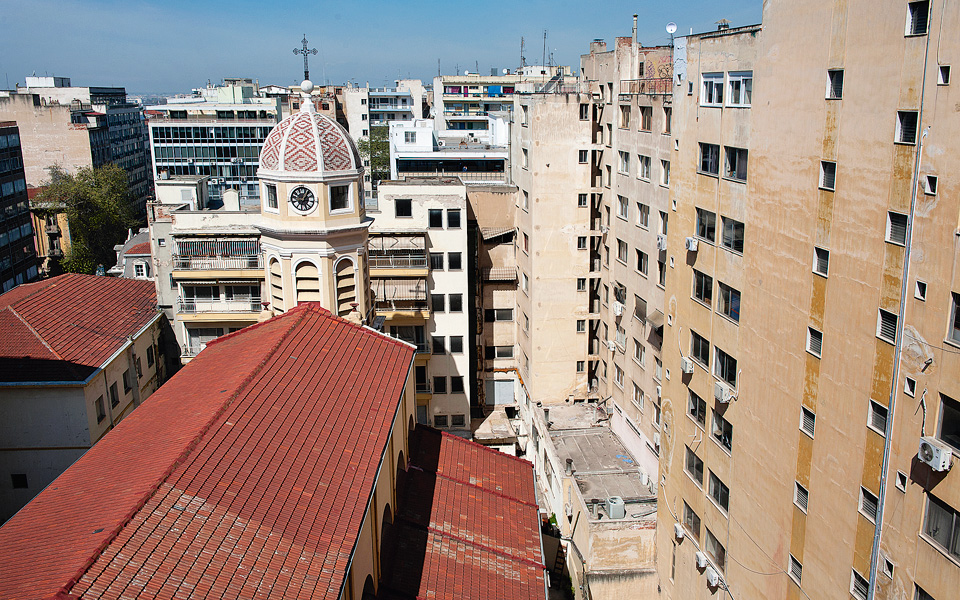
The Catholic church at the cente of Fragomachalias has been incorporated into the new space
© Alexandros Avramidis
“And the center of the area of Frangomachalas was what is today Chrimatistiriou Square, overseen by the Bank of Thessaloniki”
The rich history of this area has had an impact on the collective memory of the inhabitants here. The so-called Frangomachalas (what at the start of the 20th century was an affluent, Frankish region of mostly European residents) spreads towards the Ladadika district, near the port, and Tsimiski Street. The State Conservatory on Frangon street was erected in its current form in 1903. Inside its courtyard, one may find the oldest outdoor sculptures in post-19th-century Thessaloniki: two female forms, Economia (Economy) and Pistis (Faith). Further down is the Catholic Church, designed in 1900 by Italian architect Vitaliano Poselli. And the center of the area of Frangomachalas was what is today Chrimatistiriou Square, overseen by the Bank of Thessaloniki (known as Malakopis Arcade), also the work of Poselli.
The heart of Emporiou Square, two blocks from here, is at the meeting of Katouni and Aghiou Mina streets. Jewish traders called the square “plaza de las siete” – the place where seven roads met. Even before Thessaloniki was incorporated into the national network, until World War II, large bank branches and merchant offices operated here.
In the postwar years and up until the 90s, the area was known for its local textile and linen industry. These small industries and shops, however, gradually closed down or resettled in Bulgaria. After 2008, bars took over, opening up at the vacant old shops with very low rent. Businessmen wanting to get rich overnight arrived in the area, and soon it was transformed into a “ghetto” for night-time entertainment, until it became highly saturated.
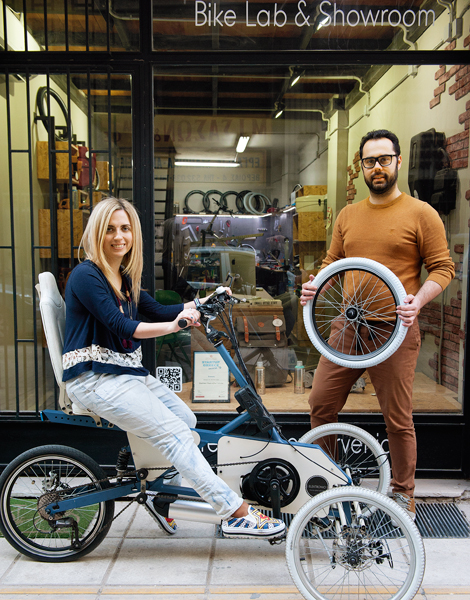
Pantelis Zarkos and Anna Chlioura are the creators of Elektronio, a startup company making electric-powered bicycles
© Alexandros Avramidis
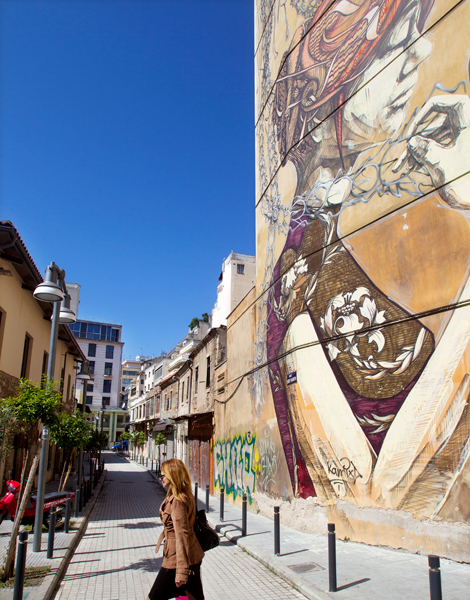
The area's bohemian character is attracting attention from investors with an eye for design
© Alexandros Avramidis
“Now it appears that, due to the (financial) crisis, there exists a milder and more rational model of development,” says Kostas Georgakis, an experienced Thessaloniki realtor. “The neighborhood has few residents but, after the redevelopment, there are new businesses opening up by people with good taste and a desire for planning: galleries, startup offices, hostels, cooperative restaurants, dance schools.”
Pantelis Zarkos and Anna Chlioura are the creators of Elektronio, a startup company making electric-powered bicycles on Verias Street. Having received awards for innovation and entrepreneurship, they settled into this area last summer after falling in love with its bohemian character. “The region is being upgraded, and more and more people come to ask about vacant stores [to rent or buy],” they note. “At first it was just a cheap solution for us; but now it is being upgraded due to actual development.” To get an idea of prices, rent for an office is at around €2-3/sq.m., and a store is €7-10/sq.m. Buying office space begins at €400/sq.m., and a store sells at around €1,000/sq.m.
Siblings Fotis and Christina Drakopoulou with Myrto Gleoudi are owners of the hip hotel Colors, located on Valaoritou Street, since 2012. They remember the area before and after its gentrification. “We have also opened up a second (hotel) at Ladadika, a more chic region, but many guests still ask for a room at Valaoritou, because they say that this neighborhood has more ‘character’,” they note. “Remodeling is a nice effort as long as it’s maintained properly so that it can last, and as long as it is respected by entrepreneurs and visitors alike. Already, some of the columns have been unhinged and graffiti has filled the walls. The problem is that we don’t have the same priorities and needs, for instance, as the bar owners. More could be done, like the hosting of bazaars and open-air fashion galas; or handing over the empty buildings to new creative groups and small designers.”
After about a week in Frangomahala, it becomes apparent that bioclimatic renovation is definitely beneficial. Yet, it is not as important as another, more profound improvement: this neighborhood, laden with historical importance and so closely entangled with Thessaloniki’s financial past, is given a second chance to flourish.
“This neighborhood, laden with historical importance and so closely entangled with Thessaloniki’s financial past, is given a second chance to flourish”
From major infrastructure projects to a...
Landmark shops, a lively cultural scene...
We asked eight of Thessaloniki’s most...
This short walk takes in eleven...